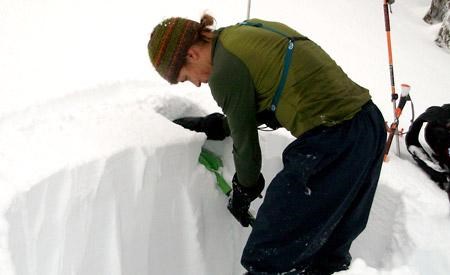by Kyle Wells [email protected] Snow is beginning to build up in the backcountry mountains of Powell River and those in the know are warning people about the dangers of avalanches and the importance of being prepared.
John Rapp, a resident of Powell River, has been a mountaineer for many years and a skier for the past five. He has personal experience with avalanches.
About 10 years ago Rapp was caught in an avalanche in the backcountry of Powell River while out snowshoeing with two friends in the Knucklehead mountain range. Rapp said neither he nor his friends knew much about avalanches at the time but that there were some obvious telltale signs. He said they joked about how it could be dangerous but kept going anyway.
All of a sudden the snow let go in a wind-loaded gully and caught Rapp and his friends up in an avalanche. The avalanche sucked Rapp under its wall of snow and dragged him and his friends about 30 to 40 metres down the mountain. When the snow settled the trio were lucky enough to all end up with their heads above the snow. They managed to dig themselves out.
Rapp said they were incredibly lucky to have survived the incident. All it would have taken was for one of them to be slammed into a rock or tree, or to have ended up buried, and the outcome could have been very different. They had no avalanche rescue gear and finding somebody buried would have been a matter of luck.
“It was wild,” he said. “It was definitely scary but it was kind of calming at the same time. You just put your faith out there and hope for the best. You kind of struggle at first to stay on top but once you’re too tired it just overcomes you, you take a big breath and down you go.”
After that experience Rapp stayed away from the backcountry in winter for a number of years. Eventually his love for the area and the snow convinced him to return, but not before getting avalanche training and making sure he was prepared.
An avalanche is a powerful and fast flow of snow down a slope. There are certain conditions that can make slopes particularly susceptible to an avalanche and the slide itself can be triggered by either natural or human causes.
The most essential step is to take a course on avalanche safety. Courses are available on Vancouver Island and elsewhere. They teach the telltale signs of avalanches, how to avoid avalanche areas, how weather and wind can affect snowpacks and what to do if caught in an avalanche. A course will also teach participants what essential safety equipment is needed and how to use it.
Rapp said he is seeing more and more people heading into the backcountry in winter and he’s concerned that many of them know nothing about avalanches and are not prepared in the case of one. Some are very aware and have the proper training to be in areas at risk of avalanches, but a great many are not.
“It’s just like a trend that’s starting to catch on,” said Rapp. “The backcountry is a dangerous place and I don’t think people are really aware.”
Most people think of the Rockies or other large mountains when they think of avalanches, but Rapp said the mountains in our backcountry are large enough and have enough of a pitch that they can be just as dangerous. Anything over a 25-degree pitch is susceptible to avalanches and there are plenty of peaks in this area that qualify.
Powell River Search and Rescue member and trainer Andy Evans said the team has never been called out for an avalanche incident in his memory but that members are trained to deal with avalanche situations. He said that as more people venture out into the backcountry he expects at some point search and rescue will have to respond to an avalanche.
“As more people get into the backcountry we will see that we’ll eventually get a call,” said Evans. “People are going to get further and further back and they will start getting into the areas where avalanches will be very susceptible.”
Evans agreed that anyone going into the backcountry should have avalanche training and that avalanche beacons should be carried. These beacons, available at many sporting goods stores, emit a signal on a common frequency that can be tracked by either companions or search and rescue teams.
Reading avalanche bulletins is the other essential step when going out into the backcountry. There are no specific bulletins for the Powell River backcountry but what Rapp does is look at the Sea to Sky bulletins and the North Shore bulletins and estimate the conditions here based upon those. Even with the bulletins, however, the conditions can vary considerably and change depending on the weather.
“I’ve been out before and had it where the snow was totally stable on a cloudy day,” said Rapp, “and the sun comes out and heats up the rock bluffs and all of a sudden there’s just avalanches coming down everywhere...That’s how quickly it can change.”
BC Coroners Service is also reminding people to take precautions. In BC last year avalanches caused the deaths of nine people, all of which were preventable in the service’s opinion. Six of the deaths occurred while snowmobiling and the other three happened while people were backcountry skiing.
“A little bit of basic understanding will go a long way,” said Rapp. “It’ll keep people safe.”
For more information on avalanche safety and on courses, interested readers can go online.



